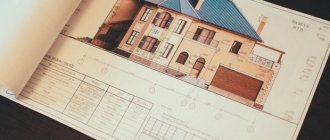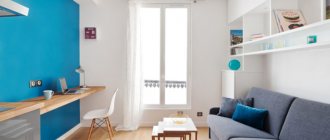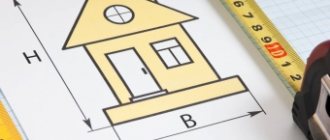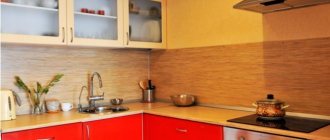One of the most popular questions among real estate buyers are questions about the area of the apartment, about how the area of the apartment is calculated . This question is only slightly inferior in popularity to the question of whether the balcony is included in the total area of the apartment.
People’s interest in this topic is understandable; the size of utility bills, market value and proper registration of the transfer of ownership of the property depend on this. In this article I will explain what the total area of an apartment is , how it differs from a residential one, why the design square footage may differ from the actual one, and I will touch on other important points regarding living space.
What is included in the OP of an apartment
The total area (TA) is understood as the sum of square meters of all rooms in the apartment, regardless of their purpose. It is indicated in the real estate purchase and sale agreement and is used in calculations for utility bills. This includes:
- Living rooms in which people sleep, relax and spend leisure time at home.
- Rooms for cooking (kitchens, kitchen-dining rooms, kitchen-living rooms, which is important for studios). They are included in the OP regardless of how much time the residents spend here.
- Corridors. They perform the function of horizontal communications, connecting individual rooms.
- Rooms for sanitary purposes. These include bathrooms and toilets (separate and combined).
- Niches in the walls of houses, used in winter as a “refrigerator”.
- Wardrobes built into the walls.
What about partitions and walls?
We are often asked the question whether partitions are included in the total area of the apartment. Yes, like any interior walls of a home. They are considered part of the auxiliary or main premises.
How are calculations carried out?
The total reduced area of housing is calculated as the total size of all available premises, including:
- storerooms;
- cabinets built into the walls;
- verandas and drying rooms;
- balconies/loggias, etc.
But how to calculate this indicator? As mentioned, the coefficients used are:
- balconies with terraces – 0.3;
- loggias – 0.5;
- verandas – 0.8;
- combined balcony with loggia – 0.4.
All this data is regulated by SNiP 01/31/2003. By law, all these premises are calculated with a reduction factor if they are unheated.
Are loggias and balconies included in the total area of the apartment?
No, they don't. According to paragraph 5 of Art. 15 of the Housing Code, the total area of an apartment is the sum of square meters of premises, including auxiliary ones and intended to satisfy any human needs, with the exception of external parts such as loggias and balconies.
Contradictions between the Housing Code and the SP (set of rules)
There are contradictions in how the total area of an apartment is calculated. According to the Housing Code, the composition does not include loggias, balconies and other similar premises, and according to the current SP 54.13330.2016 (according to Appendix A.2), on the contrary, the OP also includes unheated premises, simply calculated with reduction factors: 0.5 from the loggia and 0.3 from the balcony.
Here we need to talk about the total reduced area. This is one of the outdated concepts previously used when calculating the amount of payment for housing and communal services. The total area of the apartment is the area that includes auxiliary premises. Among them there are both balconies and loggias. But today they are considered common property, and therefore are not included in the OP.
Thus, if they want to add extra meters to the OP of your apartment, you need to refer to the fact that the provisions of the Housing Code of the Russian Federation should be taken as the basis for the calculation. The area is entered into the Unified State Register of Real Estate in accordance with Art. 15 Housing Code of the Russian Federation.
The confusion arises because in the documents issued before the amendments came into force on March 1, 2005, the area was indicated exactly with the coefficients. For this reason, many owners now have a larger area in their certificates of state registration of rights (GRP) than in the Unified State Register of Real Estate after the database has been updated.
As in the case of a loggia, the area of the balcony is not included in the total area of the apartment. According to the law, the square footage without summer premises is now indicated in the Unified State Register of Real Estate. Therefore, to the question of how a loggia or balcony is considered in the total area of an apartment, there is no answer as such. This only matters when advertising the property.
It is necessary to refer to the Housing Code in all cases:
- when calculating the amount of utility bills;
- determining the tax base;
- receiving benefits and compensation;
- real estate tax calculation;
- allocation of municipal housing;
- determining the value of real estate under the DDU (share participation agreement).
How does the total area differ from the one shown?
As already noted, the given area of an apartment is a term that is almost never used in the modern world, and instead the term total area is used. This state of affairs causes confusion among uninformed people.
Depending on the period of purchase of the apartment, title documentation may contain different data and wording. At the same time, the total area was also designated differently:
- Without loggias with balconies, as if they were absent (even if in fact they are).
- Taking into account these premises, but their area is calculated according to coefficients. Accordingly, the total area coincides with the given one.
- Taking into account the dimensions of balconies/loggias in full size, that is, without coefficients.
Despite all this, in fact there are no differences between the total and given area parameters.
How to remove a balcony or loggia from the OP
Very simple. You need to compare the data in the Unified State Register and the hydraulic fracturing certificate. The difference between the values will be on the balcony or loggia. It is important not to forget that their area was included in the OP taking into account correction factors of 0.3 and 0.5, respectively.
If the Unified State Register of Real Estate still contains old data, then as the owner you have the right to personally submit a written request, indicating the exact address of the object that contains the information to be corrected. The state welcomes this initiative, as it contributes to faster updating of information in the Unified State Register of Real Estate.
Main differences
What is the difference between the living and total area of the apartment:
- Included premises . Living space includes only those premises that are intended for living - bedroom, living room, children's room. The total area includes not only all of the listed premises, but also the remaining rooms in the apartment.
- Size. The living area is considered part of the total area, which means that it will always be smaller.
- Application . Living space directly affects living conditions. Taking into account the living space, documents are drawn up for the adoption of a child or for receiving subsidies. The total area affects the cost of the apartment and the amount of utility bills. When calculating the fee for major repairs, the total area of the apartment is also taken into account.
What is included in the common and living area?
To understand what the total area of an apartment is, it is necessary to determine which rooms are considered to be in the total area:
- All living rooms where all residents spend most of their time (bedroom, living room and other rooms where people relax, work, spend time at the computer).
- The kitchen also belongs to the common area, regardless of how much time the residents spend there: all day, or they drop in there once a day.
- Corridors connecting rooms, kitchen and other rooms.
- Combined bathrooms, as well as bathrooms and toilets, are included in the total area, regardless of how much time the owners of the apartment spend there. They do not belong to living space.
- Closets are considered part of the total area even though people don't go into them. But in this case, only those cabinets that are very small in size are taken into account.
- Niches in the walls (they are also called “Khrushchev refrigerators”), which are intended for storing food in the winter, will also be used to calculate the total area.
- Walls and partitions are considered in the overall square footage of the apartment. They are classified as main or auxiliary premises. According to the provisions of the Building Regulations 2021 and the Residential Code, such accessory parts are always included in the total area. To measure the distance of the walls, you need to take measurements along their perimeter - 1.1-1.3 m from the floor.
- Arched and door openings more than 2 meters wide, as well as internal staircases, heating sections and protruding structural elements are taken into account in the total area.
What is not included in the total area?
Many people are sure that the total area should include absolutely all the rooms in the apartment, but this is a misconception. The general quadrature should not take into account:
- Terraces and verandas - these rooms in the apartment are necessary for hobbies and growing plants in winter. They are not included in the total area.
- Not all property owners know whether the loggia is included in the total area of the apartment. According to the old standards, balconies and loggias had to be taken into account with a reduction (only 50% of the footage was taken into account), but not so long ago these premises stopped being included in the overall calculation.
- Niches less than 1.8 meters high. We are talking about closets that are too low.
- Platforms under stairs - this point applies to apartments that have two levels of living. In this case, the height of the project should not exceed 1.6 meters from the floor (measured with a tape measure strictly perpendicular to the floor).
- If the apartment has functioning stoves and fireplaces, then the space under them does not count.
- If there are arches and doors less than 2 meters wide, the threshold turns out to be too narrow, and it is not added to the total area.
- Unheated rooms in the apartment are also not taken into account. This point is especially relevant for those cases when the cost of payment for heating is calculated.
If you decide to attach a loggia to the kitchen, living room or bedroom, then be prepared for the fact that you may be fined for such actions. This option of combining rooms and a loggia is prohibited by law.
The total area should take into account niches and arched openings from 2 meters, the internal staircase and the space under it, heating stoves.
How to make calculations correctly?
The total area of the apartment is calculated using a simple scheme . To do this, you need to take measurements of the area of all rooms, and then add the resulting results together.
To measure the area of a rectangular room, it is enough to measure the length of just 2 walls with a tape measure, multiplying one value obtained by another. But this is the simplest option, which is not found so often.
If the room has a complex shape, you can divide it into several imaginary rectangles, calculate the area of each, and then add the resulting values.
If you need to calculate the area of a room in which the walls run diagonally, you can imagine a rectangle whose diagonal side will be considered the hypotenuse, and then measure its sides. All that remains is to multiply the values of all lengths and divide the result by 2. Next, you will need to add this sum with the areas of other rectangles.
For convenience, before calculating the total area of the apartment, it is better to first sketch all imaginary rectangles on a sheet of paper, so you are guaranteed not to make a mistake in the calculations. Measurements of rooms should be taken from the inside; to do this, you need to attach a ruler to the bottom of the baseboard .
What role does the square footage of an apartment play?
The following points depend on the size of the total area of the apartment.
Property value
Often sellers indicate the total area of the apartment, and the potential buyer imagines a large mansion. Therefore, it is so important to clarify the living area of the room.
Then you can avoid such situations when, due to inattention, the buyer signs a share participation agreement, and then regrets that he overpaid a considerable amount for the common living space, receiving a luxurious kitchen, a large combined bathroom and a tiny bedroom.
Calculation of heating charges
Heating radiators can be found not only in living rooms, but also in domestic premises. Therefore, the amount of utility bills in this case is calculated based on the total area.
If the owner decides to do the heating himself using electricity or gas, then to calculate the profitability of such actions the total square footage will always be taken.
Payment for general house needs
If a person has a large apartment, he will be considered a large owner . This means that he will pay more for major repairs than the owner of a small living space. In this case, the size of the apartment will be calculated taking into account the total area.
It may turn out that the owner of an apartment with a large kitchen and a spacious combined bathroom will have to pay much more than the owner of a one-room apartment with a tiny kitchen but a large bedroom.
Comfortable stay
The larger the living area of the apartment, the more spacious and comfortable the bedrooms and living rooms will be.
In which rooms can furniture of any size be placed and equipped taking into account the basic needs of the owners. The general area is no less important, since it includes the main places for storing a large number of things.
If the apartment has a large corridor, then children can play there comfortably. You can put all unnecessary things in the pantry. The common area also includes the kitchen, where people spend a huge amount of time.
Reduction factor
All premises extending beyond the common walls of the building will not be considered an apartment . According to the provisions of the Housing Code, loggias, balconies, and terraces are summer premises and are not suitable for living.
Living space - what is it?
The difference between the total and living area of the apartment can be seen in the number of rooms included in the quadrature. Based on the name “living”, it is easy to understand that this includes living rooms intended or suitable for living:
- bedrooms,
- living rooms and halls,
- children's and playgrounds,
- classrooms and libraries.
What is the difference between the living area and the total area of the apartment:
- The residential area is only part of the total area, i.e. it is always smaller. Moreover, the difference can be significant, often up to 50%.
- A kitchen, bathroom, toilet, corridors, and storage rooms are not added to the living space.
- The area of residential premises is important in determining the living conditions of citizens and affects the receipt of social benefits and the adoption of a child. The cost of housing, the amount of utility bills and property taxes depend on the OP.
The living area can be expanded due to the common area, i.e. due to auxiliary premises, such as a loggia, balcony, pantry. But in this case, the redevelopment will have to be officially legalized, otherwise it will not be possible to enter new data into the Unified State Register of Real Estate, and the additional residential squares will simply be invalid.
Freedom of contract
Often in practice, even the total area of the apartment turns out to be less than the design one. In order to extract maximum profit, developers include in the contract a condition that if the designed and actual areas of the apartment differ, the price remains fixed and is not subject to recalculation. In judicial practice, such a condition is considered acceptable.
* * *
Some courts, assessing the above contractual condition, come to the conclusion that it is legal. For example, the Tyumen Regional Court considered that it complies with the principle of freedom of contract enshrined in Art. 421 of the Civil Code of the Russian Federation does not violate the law, therefore there are no grounds for collecting money from the developer in favor of a citizen as compensation for discrepancies in areas (Cassation ruling of the Tyumen Regional Court dated October 27, 2010 in case No. 33-4673/2010).
* * *
The Court of the Nenets Autonomous Okrug also adheres to this position: at the time of concluding the contract, the parties were on equal terms and determined its terms at their own discretion. There are no mandatory norms of law or other normative act that regulate these specific legal relations and are subject to application. In this regard, the defendant cannot be entrusted with the obligation to reduce the contract price, and the plaintiff must be refused to recover the cost of the difference in the deviation of the conditional (design) area of the apartment from the actual one (Appeal rulings of the Court of the Nenets Autonomous Okrug dated 09/05/2012 in case No. 4- G-28/2012, dated 07/03/2012 in case No. 33-75/2012).
Another option is possible: in its standard contracts, the developer can include a condition that funds for a shared construction project are not subject to return if its area, according to the results of BTI measurements, turns out to be less than that (by 3%) that is specified in the contract, then there is less project area.
This condition, based on the same principle of freedom of contract, is considered by some courts to be completely legitimate (Appeal ruling of the Khabarovsk Regional Court dated 08/17/2012 in case No. 33-5117), since the difference between the design and actual area of the apartment is an acceptable construction error (Appeal ruling of the Krasnoyarsk Regional Court Regional Court dated March 24, 2014 in case No. 33-2746/2014). Let us note at the same time that in the event of a assignment of rights to an object by a citizen to a new acquirer, if a discrepancy is identified between the projected and actual area, he will not be able to recover the amount of the difference from the citizen, since he transferred to him the right to the extent that he himself had (Cassation determination of Bryansky Regional Court dated October 13, 2011 in case No. 33-3351/11).
The condition that the contract price does not change either when the total area increases compared to the design one or when it decreases will also be interpreted in favor of the developer, since it indicates compliance with the principle of equality (Determination of the Sverdlovsk Regional Court dated July 23, 2013 in case No. 33- 8434/2013), despite the fact that the developer controls the construction process and is unlikely to allow a negative difference in meters to arise.
But if the contract specifies the possibility of recalculating the price in the event of a discrepancy between the projected and actual areas, then the citizen already has the right to demand compensation in his favor from the developer if, in fact, after BTI measurements, the area of his housing is smaller (Determination of the Moscow Regional Court dated November 24, 2011 in case No. 33-24067/11).
Nuances of calculating total and living space
There are several ways to find out the total area of an apartment:
- View the object data in the Unified State Register of Real Estate. To do this, it is enough to know the exact address of the property.
- Calculate yourself. It is necessary to calculate the area of all rooms (except for the balcony and loggia), for which measure the lengths of the two walls that form each of them and multiply them.
How to calculate the living area of an apartment, knowing the total: subtract from it all non-residential premises: kitchen, bathroom, corridors, storage rooms.
In order not to overpay when buying a home and to sell real estate more profitably, you must be aware of the latest relevant information on housing laws. This will help you save money and protect your interests in controversial issues.
Features of calculating OP for rooms of different shapes
Have you decided to calculate the area of your apartment on your own? We will help you do this without errors. We suggest that you familiarize yourself with the features of calculating OP for rooms of different configurations. To work you will need paper, pencil, calculator, tape measure, laser level. Be sure to write down all obtained values. First you need to take measurements, then you can start calculating the area.
Calculation of the area of a rectangular room
The easiest way to determine the area of rectangular rooms. Let's remember geometry. To find the area of a rectangle, you need to multiply the length of its sides located perpendicular to each other. We measure the length of the two walls that are joined together. Now we simply multiply them and write the result on paper.
How not to overpay when buying a home for extra meters
Inconsistencies in wording make people think about how to avoid overpaying when buying an apartment. The main thing in this case is not to enter into a purchase and sale agreement until the situation is completely clarified. You need to ask the seller whether the various outbuildings are included in the total area of the property. If the seller initially plans to deceive the buyer, he will answer in a vague way, avoiding the answer. The developer may refer to the impossibility of accurate calculations due to unfinished construction.
It is important to carefully study the BTI conclusion. When the state commission accepts a finished project from the developer, the exact construction area must be known. For each individual apartment, BTI employees issue a certificate containing information on the application of the reduction factor, if necessary.
If the developer included his own coefficients in legal acts, this is considered a serious violation. In this case, you can go to court for compensation for damage, since the information in the documentation does not comply with CHIP standards. In court, you can also rely on the Housing Code, namely Art. 15. Types of residential premises, their differences and characteristics are described in Art. 16 ZhK RF.
It is important for every owner to know what area in the apartment is considered residential and what is considered common. This information is necessary for the correct calculation of utility bills, establishing the cost of the property and performing various registration actions. That is why you need to be especially careful when reading the documents. If an error is detected, you must immediately contact Rosreestr.
Division into types
Information about the types of premises is a component of the cadastral passport. On the cadastral plan, the specialist marks different areas with different colors. As a rule, red means residential premises, and blue means non-residential.
Having determined what the living space of an apartment is, it is necessary to stipulate exceptions; it does not include:
- niches less than 1.8 m high;
- a place located under the staircase, if the height of the stairs is less than 1.6 m (if the apartment has two levels);
- the area under the fireplace or stove (provided that they are functional);
- door openings;
- arches less than 2 m wide.
Thus, the living area is the sum of all rooms, with the exception of non-residential premises. Let's consider why it is necessary to divide the premises of an apartment by type.
First of all, on the basis of such calculations, utility bills for housing are calculated. The amount of heating fees directly depends on the living space.
The second payment, calculated on the basis of the area, is the cost of general house needs. The total payment for the house is divided proportionally among all residents, according to the size of their living quarters.
Controversial issues
Since the current laws of our country are constantly being modified, many controversial issues arise on this issue and very often. After all, most of the nuances are regulated by various documentation and by-laws that are not accessible to the average person.
Important! All data on the characteristics of residential premises, based on the construction project and measurements of BTI employees, are displayed for reference in the object acceptance certificate.
Thus, the area of a loggia or balcony will be of a reference nature in BTI documents. Based on these indicators, a reconciliation is underway between the developer and the BTI.
Check encumbrances and restrictions on the apartment
You can check the apartment at the address, using our service, for the presence of encumbrances, arrests and restrictions, just order an extract from the Unified State Register using the official Rosreestr service. You will also find out who is the owner of the apartment (full name) and their number, and when the ownership was registered.
An apartment inspection is needed when buying, when appraising an apartment and when selling.
All data from the Unified State Register of Real Estate is provided by the official website “Rosreestr Online” in real time, with the date in the document at the time of placing the order, according to the federation. Law No. 218 of July 13, 2015 “On state registration of real estate”
How can you find out the number of residential square meters?
If for some reason the user needs, knowing the cadastral number, to find out how many exclusively residential square meters are in the apartment, he will have to request an extract from the Unified State Register of Real Estate.
You can find out the number of square meters as follows::
- Apply directly to your local Rosreestr office.
- Submit an application through the MFC using the “My Documents” type.
- Order an online statement on the official website of Rosreestr or through the Gosuslugi portal.
- Send the application by mail, having your signature certified by a notary.
All of these methods require payment for services for preparing the extract. Its size will be:
- For citizens – from 300 rubles.
- For organizations – from 950 rubles.
On the Rosreestr website you can order a copy of the technical housing plan instead of an extract.
This document will also indicate the size of the living space. However, one must keep in mind: such a document is more expensive: even for citizens, even an electronic copy costs at least 500 rubles.
Having a technical plan in hand, you can calculate the area of residential premises yourself , simply by measuring them on the plan and recalculating the scale.









